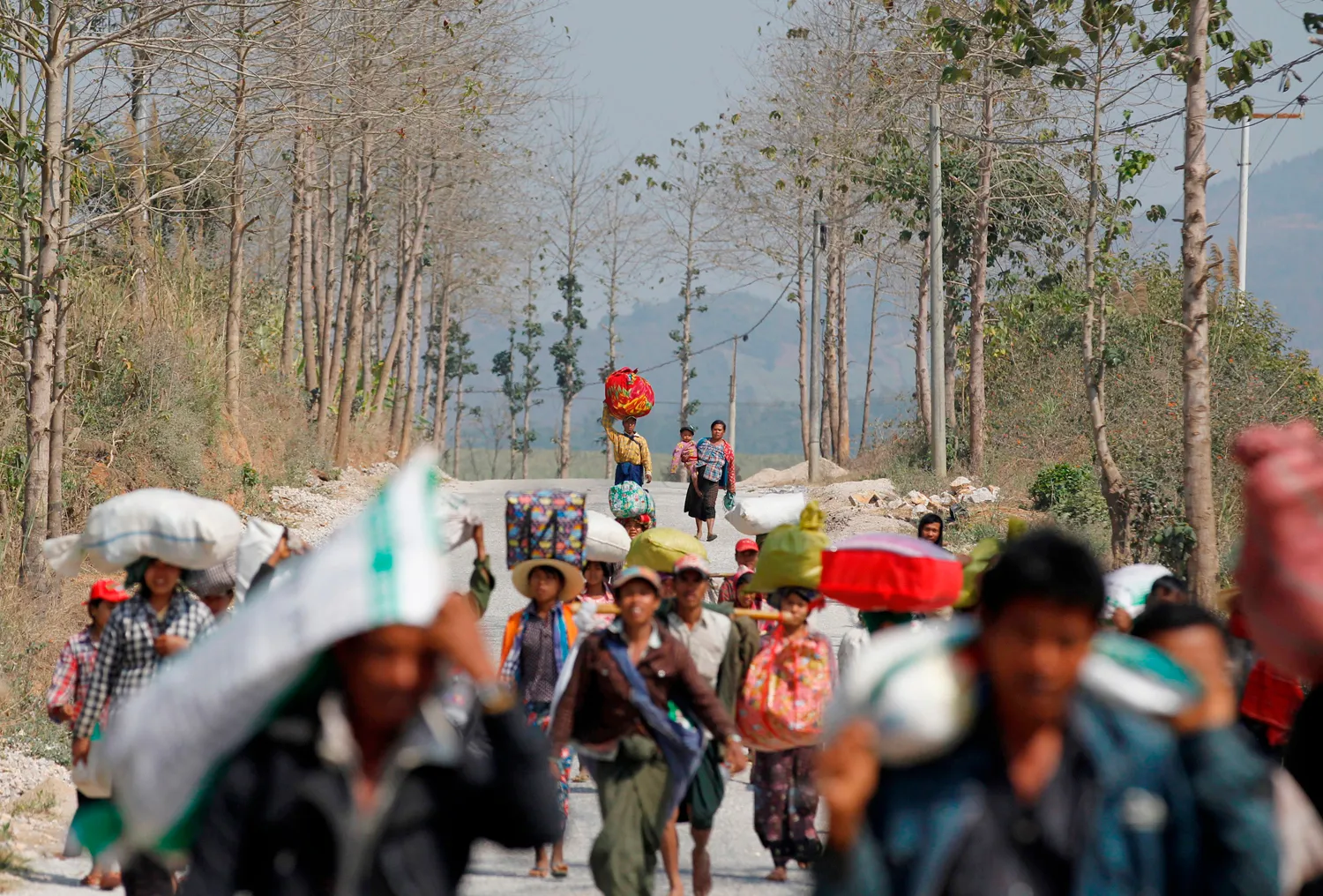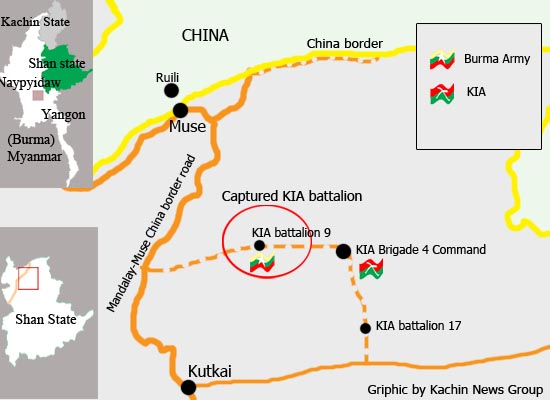The United Nations reported on Friday that violence in northern Myanmar since an alliance of ethnic armed groups launched an offensive against the military two weeks ago has displaced nearly 50,000 people.
Analysts assert that the military confrontation in northern Shan state, close to the Chinese border, which has been ongoing for the past two weeks, presents the junta with its most significant military obstacle since assuming jurisdiction in 2021.
Myanmar National Democratic Alliance Army (MNDAA), Ta’ang National Liberation Army (TNLA), and Arakan Army (AA) claim to have obstructed vital trade routes to China and occupied dozens of military outposts.
As of November 9th, the United Nations Office for the Coordination of Humanitarian Affairs (UNOCHA) reported in an update that the number of individuals compelled to abandon their homes in northern Shan had approached 50,000.
Internet and phone services were disrupted outside of Lashio township in Shan state, which houses the military’s northeastern command. This impeded humanitarian responses to the conflict, according to UNOCHA.
It stated that limitations on cash availability and transportation restrictions impeded the ability of local humanitarian organisations to distribute assistance.
Conflicts between the military and its adversaries in the neighbouring Sagaing region and Kachin state have displaced an additional 40,000 individuals since early November, according to UNOCHA.
The junta-appointed president warned earlier this week that if the military failed to “manage” the combat, the country could “splinter into various parts.” The military has made few comments regarding the surprise offensive.
Volatile communications and the inaccessibility of the treacherous, jungle-covered region—which contains pipelines that deliver gas and oil to China—make it challenging to confirm casualty counts.
A significant junta ally and munitions supplier, Beijing confirmed Chinese casualties in the Myanmar conflict on Tuesday.
An individual representing the foreign ministry refrained from specifying the location of the incident or the number of fatalities or injuries among the Chinese.
Over a dozen ethnic armed groups reside in the borderlands of Myanmar; some of these groups have engaged in protracted conflicts with the military regarding autonomy and the control of valuable resources.
Since the coup, some have provided training and equipment to the more recent “People’s Defence Forces” (PDF), which have emerged to oppose the military’s violent suppression of opposition.
Earlier this week, multiple PDF factions asserted control over the Sagaing region town of Kawlin, which is historical and culturally significant to the Bamar people and has served as a military recruiting centre. Residents of the area were inaccessible to AFP due to the extensive downtime of phone lines and internet connections.
Sagaing, which shares borders with the states of Shan and Kachin, has emerged as an epicentre of junta resistance. Decades of PDF organisations are active throughout Sagaing, an area where the military is under suspicion of torching villages and murdering their inhabitants.
In the interim, rebel factions in Myanmar assert that they have amassed a string of victories on the battlefield against the governing junta, posing what security analysts consider to be the greatest challenge to the military’s hold on the country since a coup in 2021 overthrew a civilian government and seized power.
The surprise offensive, which originated in the northern region, has, according to the United Nations, displaced tens of thousands of people along Myanmar’s border with China. Opposition from Beijing and strain in the military’s rapport with one of its limited allies have resulted from the disruption of border businesses caused by the campaign.
Since the rebellion, pro-democracy insurgents in the country’s interior have joined forces with ethnic armed groups along its borders, thereby subjecting the Myanmar military to attacks from multiple fronts during its nearly three-year civil war. The military has employed ruthless tactics in an attempt to quell the resistance, which human rights organisations assert are likely war crimes.
A coalition of three ethnic armed groups that had largely abstained from the conflict until October 27th launched an abrupt, well-coordinated offensive in the province of Shan, located in the strategic northern region adjacent to Laos, Thailand, and China.
The assertion that the Three Brotherhood Alliance had seized control of over a hundred military outposts, main highways, and border crossings in the span of ten days is anticipated to have a financial impact on the junta. Social media platforms are filled with images and videos that depict rebel soldiers triumphantly marching through townships while posing in front of weaponry purportedly stolen from military battalions.
A junta spokesman, General Zaw Min Tun, made the unprecedented disclosure to a state broadcaster last week that the military had relinquished control of three towns in Shan.
“It took us a long time to plan this operation,” Tar Aik Kyaw, an alliance spokesman for the Ta’Ang National Liberation Army, explained in an interview. “Everything had to be methodically prepared… in order to reduce casualties on our side.”
He further stated that the Arakan Army and the Myanmar National Democratic Alliance Army, two allied organisations of the Ta’Ang National Liberation Army, “welcome any other group fighting against the military.”
Myanmar Witness, an organisation that has been verifying information about the civil war, has initiated the collection of a substantial quantity of visual evidence of the offensive, according to a spokesman for the organisation. “This is a significant development from a region of the country where conflict incidents on open source channels are typically infrequent,” spokesman Matt Freear explained.
In the days following the northern offensive, insurgents and rebels in the southern and central regions of the nation launched their own assaults. Towards the vicinity of Mandalay, in the Sagaing region, pro-democracy organisations announced on Tuesday that they had reclaimed two townships previously ruled by the military. This marked the first time since the military took control of the area.
Many of the country’s armed groups are too minor to overthrow the military on their own, but they have demonstrated an unprecedented level of cooperation over the past week, according to Zachary Abuza, a scholar of Southeast Asian security issues at the National War College in Washington. “They are moving in unison and paying attention to one another. “That is the intriguing aspect of this situation.”
The Three Brotherhood Alliance comprises factions that maintain strong affiliations with China and rank among the most formidable armed actors in the region adjacent to Myanmar’s border. The alliance, in contrast to certain other rebel factions, refrained from promptly aligning with the resistance following the coup. Instead, it proclaimed itself neutral with regard to the conflict between the military and the pro-democracy movement.
However, as the junta escalated bombardment across the country this year, alliance units commenced engagements with military forces in Shan. The proliferation of illicit activities in regions under military control further escalated tensions. Alliance leaders stated that the elimination of cyberscam operations, which have flourished in the lawless region of Kokang, was one of the objectives of the assault.
The conflict has obstructed trade and travel between northern Shan and China, potentially preventing the military from obtaining a significant source of funding.
China announced on Monday, in response to the offensive, that Assistant Foreign Minister Nong Rong had visited Myanmar over the weekend and urged officials to “maintain stability” along the border. The extent to which Beijing was cognizant of the alliance’s strategy for an unexpected assault is not immediately evident.
Commemorating the offensive as a pivotal moment in the conflict, pro-democracy movement leaders and supporters have expressed their delight. The rebel groups, however, are operating for their own benefit, and their connections to the pro-democracy movement are, at best, tenuous, according to analysts. In recent days, the chief military commander of the military, Min Aung Hlaing, has also pledged to launch counteroffensives.
Subsequent to its October seizure of two military encampments in the vicinity of Shan, an additional rebel faction known as the Kachin Independence Army has encountered an onslaught of artillery and airstrikes. People have been in concealment at the group’s command centre in the town of Laiza for over a week, according to Col. Naw Bu, a spokesman for the organisation.
Myanmar Army Accused of Using Thai Citizens as Human Shields
Myanmar Army Accused of Using Thai Citizens as Human Shields











